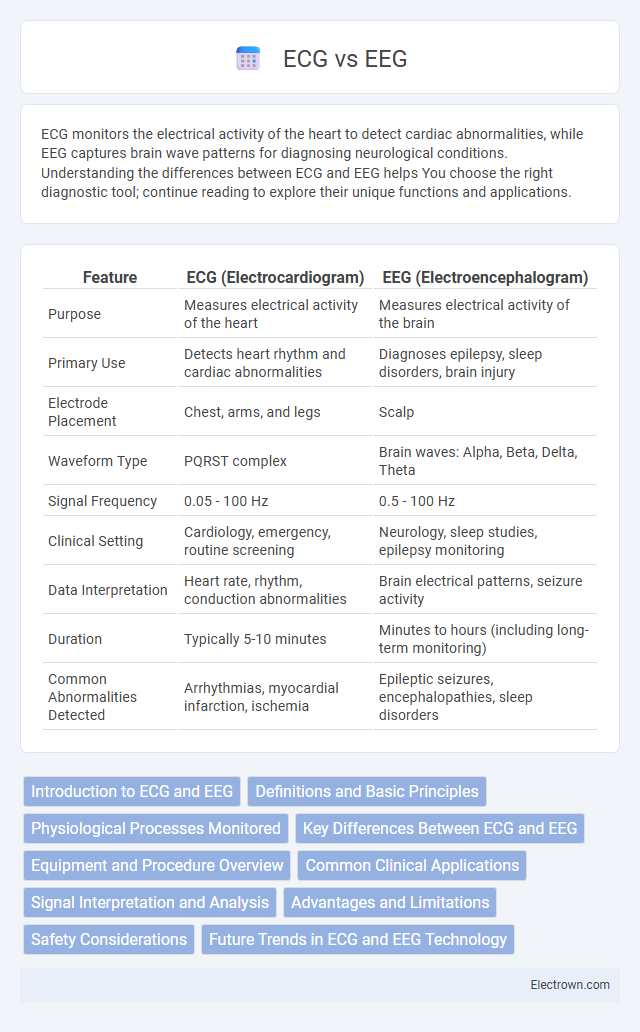ECG monitors the electrical activity of the heart to detect cardiac abnormalities, while EEG captures brain wave patterns for diagnosing neurological conditions. Understanding the differences between ECG and EEG helps You choose the right diagnostic tool; continue reading to explore their unique functions and applications.
Table of Comparison
| Feature | ECG (Electrocardiogram) | EEG (Electroencephalogram) |
|---|---|---|
| Purpose | Measures electrical activity of the heart | Measures electrical activity of the brain |
| Primary Use | Detects heart rhythm and cardiac abnormalities | Diagnoses epilepsy, sleep disorders, brain injury |
| Electrode Placement | Chest, arms, and legs | Scalp |
| Waveform Type | PQRST complex | Brain waves: Alpha, Beta, Delta, Theta |
| Signal Frequency | 0.05 - 100 Hz | 0.5 - 100 Hz |
| Clinical Setting | Cardiology, emergency, routine screening | Neurology, sleep studies, epilepsy monitoring |
| Data Interpretation | Heart rate, rhythm, conduction abnormalities | Brain electrical patterns, seizure activity |
| Duration | Typically 5-10 minutes | Minutes to hours (including long-term monitoring) |
| Common Abnormalities Detected | Arrhythmias, myocardial infarction, ischemia | Epileptic seizures, encephalopathies, sleep disorders |
Introduction to ECG and EEG
Electrocardiogram (ECG) measures the electrical activity of the heart to assess cardiac health and detect arrhythmias or myocardial infarction. Electroencephalogram (EEG) records electrical brain activity via scalp electrodes, crucial for diagnosing neurological disorders like epilepsy and sleep disorders. Both ECG and EEG provide non-invasive, real-time monitoring essential for clinical diagnostics in cardiology and neurology.
Definitions and Basic Principles
Electrocardiography (ECG) records the electrical activity of the heart using surface electrodes, detecting depolarization and repolarization patterns essential for assessing cardiac rhythm and function. Electroencephalography (EEG) captures electrical brain activity through scalp electrodes, measuring cortical neuron oscillations and brain wave frequencies for neurological monitoring. Both techniques rely on non-invasive bioelectrical signal detection but target distinct organs with unique electrophysiological properties.
Physiological Processes Monitored
ECG monitors the electrical activity of the heart, detecting rhythm, rate, and cardiac abnormalities by measuring the heart's depolarization and repolarization cycles. EEG records electrical activity in the brain, capturing neuronal firing patterns related to brain wave frequencies such as alpha, beta, delta, and theta waves. While ECG reflects cardiovascular function, EEG provides insights into brain states, including sleep stages, seizure activity, and cognitive processes.
Key Differences Between ECG and EEG
ECG (Electrocardiogram) measures the electrical activity of the heart, while EEG (Electroencephalogram) records electrical activity in the brain. ECG is primarily used to diagnose cardiac conditions such as arrhythmias and myocardial infarctions, whereas EEG helps detect neurological disorders like epilepsy, sleep disorders, and brain dysfunctions. The electrodes for ECG are placed on the chest and limbs, contrasting with EEG's scalp electrode placement to capture brain wave patterns.
Equipment and Procedure Overview
ECG equipment consists of electrodes placed on the chest and limbs to measure the heart's electrical activity, capturing waveforms that reflect heartbeat rhythms and heart health. EEG uses multiple electrodes attached to the scalp to record brain electrical activity, providing data on neural oscillations and brain wave patterns. Your choice between ECG and EEG depends on whether cardiac or neurological monitoring is needed, as each involves distinct setups and procedural methods tailored to their specific diagnostic purposes.
Common Clinical Applications
ECG (Electrocardiogram) is primarily used for diagnosing and monitoring heart conditions such as arrhythmias, myocardial infarction, and ischemic heart disease. EEG (Electroencephalogram) is indispensable in neurology for detecting epilepsy, sleep disorders, and brain dysfunctions like encephalopathies and tumors. Your healthcare provider may recommend ECG to evaluate cardiac health, while EEG assists in assessing brain activity and neurological disorders.
Signal Interpretation and Analysis
ECG (Electrocardiogram) signals represent cardiac electrical activity through characteristic waveforms such as P waves, QRS complexes, and T waves, enabling precise analysis of heart rhythm and conduction abnormalities. EEG (Electroencephalogram) signals capture brain electrical activity via rhythmic patterns and frequency bands like alpha, beta, delta, and theta waves, facilitating the detection of neurological conditions including epilepsy and sleep disorders. Signal interpretation in ECG relies on peak detection and interval measurement, whereas EEG analysis employs spectral decomposition and pattern recognition to identify neural oscillations and abnormal brain states.
Advantages and Limitations
ECG (Electrocardiogram) provides precise measurement of cardiac electrical activity, offering real-time monitoring of heart rhythm and aiding in the diagnosis of arrhythmias, myocardial infarction, and other cardiovascular conditions. EEG (Electroencephalogram) excels in detecting electrical activity in the brain, making it crucial for diagnosing epilepsy, sleep disorders, and brain dysfunctions but has limited ability to localize deep brain structures. While ECG is non-invasive with high temporal resolution and widely available, it cannot assess neurological states; EEG, although non-invasive and valuable for neurodiagnostic purposes, is susceptible to artifacts and has lower spatial resolution compared to imaging techniques.
Safety Considerations
Electrocardiogram (ECG) and electroencephalogram (EEG) both utilize non-invasive electrodes to monitor electrical activity, minimizing risk when performed correctly. ECG is generally safer for continuous monitoring, as it involves fewer electrodes and less susceptibility to signal interference or skin irritation compared to EEG. EEG requires careful electrode placement and patient cooperation to avoid artifacts and ensure accurate brain wave recordings, with no known long-term adverse effects when standard protocols are followed.
Future Trends in ECG and EEG Technology
Future trends in ECG and EEG technology emphasize enhanced precision through AI-driven data analysis, enabling real-time diagnostic insights and personalized treatment plans. Wearable devices with improved sensor accuracy and wireless capabilities are expanding continuous monitoring options for cardiac and neurological health. Your access to advanced, non-invasive tools will facilitate earlier detection of anomalies and streamline healthcare management.
ECG vs EEG Infographic

 electrown.com
electrown.com